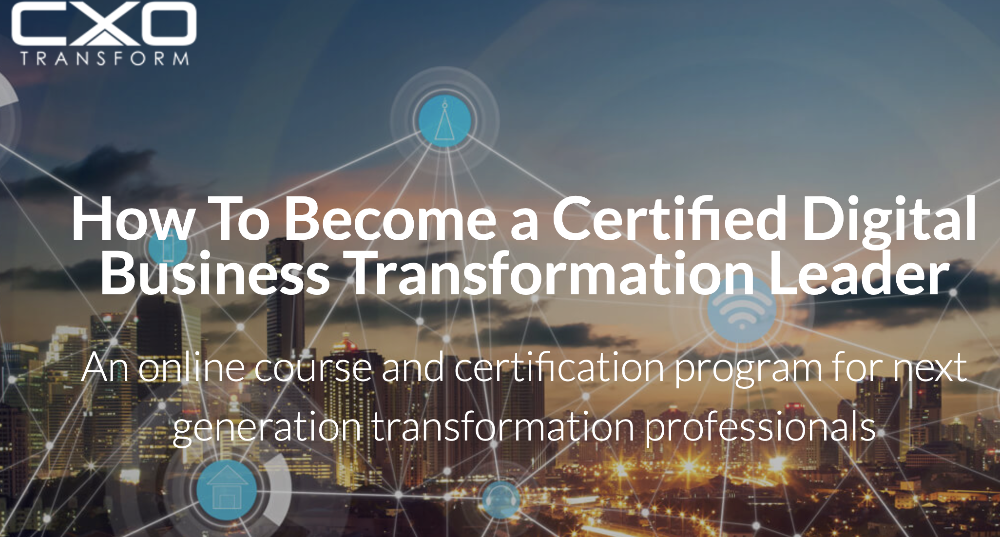Leading Digital Transformation is a weekly podcast series produced in collaboration between The Digital Transformation People and Rob Llewellyn digital transformation advisor and founder of CXO Transform.
During this series, Rob interviews experienced practitioners, authors and thought leaders whose stories and experiences provide valuable insights for digital transformation success.
In this episode, Rob speaks to Professor Wendy Smith, Professor at the University of Delaware and the Co-Founder and Co-Director of the Lerner Women’s Leadership Initiative. Wendy’s particularly interested in how organizations and their leaders achieve peak performance by living in the AND to embrace paradox. Her research explores how top management teams embrace exploration and exploitation simultaneously, as well as how social enterprises engage social and financial tensions simultaneously. This research has been published in places such as the Academy of Management Review, Organization Science, Harvard Business Review.
“If you pick between managing for today versus managing for tomorrow, that’s a great solution for the short term but can be detrimental for the long term. Paradoxically whilst today and tomorrow feel like they’re in competition and oppositional they should actually reinforce each other. Adopting a Both/and approach and really experiencing or addressing these simultaneously allows us to be so much more creative with new ideas. It allows us not only to generate new possibilities but also to resolve these tensions in a whole different way. And what we find in our research is that great leaders are the ones who really know how to navigate these kinds of paradoxes and know how to adopt a Both/and approach to overcome the challenges that they face”
Listen here and read the full transcript below.
Rob Llewellyn [00:00:22] Digital transformation involves ongoing tensions between succeeding for today while transforming for tomorrow. I’m joined today by Wendy Smith and Wendy’s work explores how adopting a “Both/and” approach to these kinds of tensions can enable individuals and organisations to achieve results that are more creative, generative, and sustainable. To learn more about this, let’s jump into the interview with Wendy. Wendy, welcome.
Wendy Smith [00:00:54] Rob, thanks for having me. It’s great to be here with you.
Rob Llewellyn [00:00:56] Fantastic to have you. Wendy, I was reading an article on HBR, on the Harvard site in which you talk about the Both/and approach. Tell us, firstly I want to know how you got into this and what really is a Both/and approach.
Wendy Smith [00:01:17] Yeah, I really stumbled on this idea of Both/and thinking, a Both/and approach when I was doing research for my PhD dissertation and it was the late 1990s and I was studying IBM and how their strategic business units were managing change. So it was the time when technologically we were moving into cloud computing or what we now know as cloud computing. And there was a lot of uncertainty about the new technology at the time. And the leaders, the general managers of these business units were being tasked with unpacking, understanding, introducing, really exploring extensively this new world of cloud computing. And at the same time, managing their existing businesses, two or three-million-dollar businesses and maintaining that business. And yeah, if you read a lot of the research and literature on change, one of the main approaches to managing change at the time was, you know, figure out where you’re going to go, decide your new strategy and then go as quickly as possible, rip the Band-Aid and get everybody on the bus, whatever metaphor you want to use so that you move into the new world quickly. And when I was studying these teams, you know, that was all nice and good. But the truth is that they wanted to go quickly into the new world and didn’t want to leave millions of dollars on the table from their existing world. So in reality, the question that they were asking wasn’t, how do I move into the new world quickly? How do I move into this cloud computing technology quickly? It was really a question of how do I move into this cloud computing technology quickly and at the same time manage for this existing world, manage our current customers in our current markets. And that was a really different question than simply how do I rip the Band-Aid and move fast to the new world, because it involved recognising that these two different worlds, the world of today and the world of tomorrow, were really different types of businesses to manage. They involve very different roles. They involved competition for resources and competition for their sales team and their engineers. And at the same time, they had to rationalise and figure out how these two worked together and lived side by side in the same business. So the notion of Both/and is really about how leaders (and how we all, frankly) face the kinds of competing demands like these IBM leaders did, these sort of tensions between today and tomorrow and navigate by living in both of these at the same time rather than trying to decide between one or the other. And I’ll just say that in the world of change and transformation, this happens all the time. But it’s also connected with a whole lot of other kinds of competing demands. So, how do we both address a global audience and integrate globally and connect with global resources and at the same time address really local, distinct, unique needs? This tension between global and local, or how do we increasingly today in our world manage for real financial outcomes and competitive advantage in markets and at the same time, pay attention to a broader sense of social impact, environmental impact, broader missions at the same time? And these are the kinds of tensions that we can’t choose between organisations and leaders really have to address both simultaneously. And that’s what a Both/and approach is trying to engage with, is trying to address.
Rob Llewellyn [00:04:57] So Wendy, you mentioned competing demands and I think most of our audience, which consists of managers and leaders, will resonate with that. Why does our approach to competing demands matter for digital transformation and the challenges that these managers and leaders are facing these days?
Wendy Smith [00:05:17] Yeah, well, I think there’s sort of two ways to answer that. The first is that what we see in research and what I think your managers and leaders would probably experience is that the pressures to address these competing demands are increasing in our world today. And that’s partially because, you know, what we found in our research is that these kinds of competing demands become more salient to us. We experience them more, we feel the anxiety and the pressure more under a certain set of conditions. So first of all, it happens more when there’s more change in the world because tomorrow becomes today more quickly. So I’ve a colleague who did some research years ago on the cement industry and the pressures of change in the cement industry are rather slow. So that this pressure between the competition between tomorrow and today, you just don’t feel it as much. But in our really fast-paced, incredibly innovative world, we do feel that pressure where we have to stay agile and tomorrow becomes today more quickly. We also feel these kinds of pressures more in a world that is more globalised because the more different voices we have – we talk about it as plurality or diversity – the more that we feel competing demands between different groups of peoples’ needs. And the third is that we feel these kinds of competing demands more under conditions where we experience greater scarcity. Now, we don’t have to live into that scarcity, but when we feel like there’s more limited resources, then the tensions between two things and how we allocate those resources become even greater. So in our world today, in our sort of volatile, fast-paced world, we’re feeling these competing demands more, they’re more salient. We experience them more. And I think your listeners would probably experience that where there’s just more pressure to address these more. That said, I think the other thing that we are learning, so not only does it happen more often, I think we’re also learning that “either-or” approaches to these competing demands, so if you pick between managing for today versus managing for tomorrow, that’s a really good solution for a short term, but can be really limiting or in fact detrimental for the long term. So it’s not just that our world has more of these competing demands, by the way. The term we use for that is that these are paradoxical, that today and tomorrow feel like they’re in competition and oppositional and at the same time they reinforce each other. So it’s not just that you experience more of these paradoxes, but that an “either-or” approach to them can be really limiting or said differently. A Both/and approach, really experiencing or addressing these simultaneously allows us to be so much more creative with new ideas. It allows us to really generate not just new possibilities, but live into these tensions in a whole different way. So we find in our research is that great leaders really know how to navigate these kinds of paradoxes, really know how to adopt a Both/and approach to the challenges that they face.
Rob Llewellyn [00:08:21] Wendy, you just mentioned that a Both/and approach can allow us to be more creative? How does a Both/and approach allow us to be more creative? And what about sustainability also?
Wendy Smith [00:08:33] Yeah. So here I’ll point back to a psychiatrist. His name is Albert Rothenberg, and he did some research years ago where he said, you know, like a lot of psychiatrists do research on why people have problems, are depressed or anxious. He was really interested in what makes people geniuses, what drives really creative genius ideas. So he went back to look at some of the great geniuses across different disciplines. So like Albert Einstein and Mozart and Picasso and Virginia Woolf. And what he did was analyse their writings and their diaries and their insights. And he found that what drove many of these creative insights was the juxtaposition of opposing ideas and the search for how those ideas could live in relation to one another. So for Einstein, the theory of relativity comes from trying to assess or understand how an object could be both at motion and at rest at the same time. And he called this Janusian thinking after the Roman god Janus, who was the two-faced God, looking two ways. So one of the ways in which this Both/and approach leads to more creativity is just that the juxtaposition of competing ideas – how do I live in today and tomorrow – generates new insights for people. Just asking the question invites you to think in different ways about different options of how we could approach problems. The same is true in our personal lives. How do I become the best person that I can in my career and at the same time have a robust and thriving personal life, live in this work-life balance? How do I do that? So instead of having to make a decision, am I going to be career-oriented predominantly or focus on the rest of my life? How do I really navigate the tensions on an ongoing basis between these two? And sometimes when we talk about a Both/and approach, sometimes we say, look, just changing the question invites us to be so much more creative in the kinds of competing demands that we experience and that we feel. The same is true for innovation. You know, how do I, changing for the IBM general managers or for anybody, how do I live in this digital new world and at the same time manage and address my current customers? invites us to think in all kinds of new ways about how we can structure our business and how we manage our business and how we work through these tensions.
Rob Llewellyn [00:10:56] So as people endeavour to use this Both/and approach, what are some of the challenges that they can expect to need to overcome?
Wendy Smith [00:11:08] Yeah, well, you know, I think here I’m going to go to the head and the heart, you know, how we think about things and how we feel, because in both cases we experience some significant challenges around this. So cognitively in our mindsets, we don’t usually “like”, it’s kind of uncomfortable. It’s kind of to really believe live into that two different things can exist simultaneously that are oppositional to one another. You know, this is particularly true in our research. We find that sometimes we have different perspectives about these kinds of competing demands in the West and in the East. And eastern philosophy and its yin-yang thinking tends to be more comfortable with living into black and white simultaneously than in the West. You know, in the West, we find this to be a problem that needs to be solved. So, you know, we can go all the way back to Greek philosophers and the notion of paradox and like the classic paradox is the liar’s paradox, right? The statement, I am lying. And if you look at the statement “I am lying”, within that statement is both truth and falsehood. So if you’re lying and you say “I’m lying”, I’m telling the truth. And if you’re not lying and you say “I am lying”, then it’s false. And so in some ways, this paradox has animated philosophers to years to try and resolve it. What we know about paradox, though, and great leaders that can really live with Both/and is that the goal is to live into and accept that these competing demands happen at the same time and not resolve them to live with them. That’s really hard to do because cognitively we want a solution. We want a clear cut, rational way of thinking about things. And then, you know, the other piece is that I think one of the reasons we want this is because emotionally it’s uncomfortable to live in these competing demands simultaneously, partially because if we have two ideas out there at the same time, we want certainty. So we want certainty, for example, from our leaders. So let’s say leaders have this competing demand between are we globally unified or are we going to advance something more local and distinct? And, you know, we want leaders to be really certain. We want people, we want ourselves to be really certain. We feel uncomfortable with the uncertainty or the ambiguity that comes up when we don’t have an answer to that question. So I’ll give you an example. Up the street from me at the business school, University of Delaware is W L Gore and Associates. And Gore is an incredibly innovative material sciences company. Some people might know Gore. They make Gore-Tex. So and it’s a polymer that’s in a whole lot of products from our Gore-Tex jackets to dental floss to guitar strings and medical equipment. And Gore really innovated by making a bet on the culture of what they call “the power of small teams”. So, you know, really local teams where decision making was pushed down locally and people have a lot of autonomy. And, you know, a number of years ago when Terri Kelly, who’s now their former CEO, came in as CEO, what she found was that the power of small teams was incredibly important to them culturally and incredibly useful when they started out as about 200 people in one facility in Newark. But as they moved to 30,000 people across 35 different locations, small teams were running around doing a whole lot of things in a whole lot of different places. And what they really needed was an enterprise-wide global strategy that somehow integrated all of these small teams. Well, this made people at Gore really uncomfortable, because they had placed a bet on, their culture was really about small teams. And the question that Terri Kelly was trying to ask was “how can I create both a global integrated strategy and at the same time support continue, advance these local small teams?” But this was really uncomfortable for the people at Gore, who felt like introducing a more integrated global strategy where there was going to be more decision making at the senior leadership level in an integrated level, felt like it was an immediate dismissal of what they had known so far, which is this local autonomy. So how can you live in these competing demands? It feels uncomfortable and it’s really hard to do sometimes.
Rob Llewellyn [00:15:43] So, Wendy, I know you’ve done a lot of research on this subject. What have you found in that research about how to address these challenges of navigating a Both/and approach?
Wendy Smith [00:15:57] Gosh, Rob, there’s so much to say here. And, you know, the number one thing I would say, like I would say that if your listeners walk away from this conversation with one “a-ha”, an entry-level a-ha, it’s what I was saying earlier, which is that first and foremost, simply changing the question opens up all kinds of new possibilities. So, you know, again, with IBM, the question they were asking is, how do I innovate? And simply changing the question to how can I innovate while simultaneously managing this, you know, million-dollar existing business, simply just changing the question opens up all kinds of new possibilities for them. You know, there was a psychologist, Watzlawick. And he said: “the problem is not the problem. The problem is how we think about the problem.” And so it’s almost that professional hazard that when somebody says to me, well, we could do this or this. My gut reaction living in sort of the Both/and thinking is “OK, well, that’s good, but how is there a way to just start with how can we accommodate A and B, whether A and B is the existing world and the new world or whether A and B is a centralised, integrated approach or decentralised sort of local autonomy?” How can we accommodate these things is really the first step to managing or I think the number one piece to walk away with Paradox 1.0, Both/and 1.0. Now, once you do that, then you get into the complicated questions of, OK, well, once we change the questions, what do we do? And here I think, you know, again, there’s much more to say about this. But I do think that one of the big pieces of changing to a Both/and question then depends on articulating either what we call an overarching vision or an integrated identity, but some way of articulating both a big-picture identity that you’re competing demands into and at the same time looking at these competing demands and saying what’s different, what’s unique about them and what’s distinct. And so we talk about that as separating and connecting, identifying the competing demands, finding what’s different and unique about them, and then exploring how they fit into an overarching vision so that you can accommodate them both simultaneously.
Rob Llewellyn [00:18:25] So based on these ideas you’ve been sharing with us, Wendy, what challenges animates your work today?
Wendy Smith [00:18:31] Yeah, I mean, there’s a whole bunch again. The more that we talk about this, the more that people say to us, oh, gosh, this is exactly what I experience. And I’ve sort of posed one of the things that we’ve written about in an HBR article was what we think of as the three big strategic paradoxes for organisations. And I share those to begin with. So we think of it as an innovation paradox, the tension between today and tomorrow, a globalisation paradox, the tension between being globally integrated and locally distinct, and an obligation paradox, or the tension between paying attention or having obligations to your bottom line and financial demands and to a broader social impact. And I think, you know, as I said earlier, I think what we experience when we talk to leaders and these aren’t just senior leaders, but leaders at all levels, is that people experience this more and more. So what we continue to be interested in is can we unpack these in more depth? One big question that leaders have asked is, you know, how do I communicate about these to a broader group of people? So let’s say like I get it. You know, we’ve interviewed and had conversations with Paul Polman at Unilever or who recently left Unilever, and he was really committed to a strategy, the Unilever’s sustainable living plan or a sustainability strategy that really made a commitment to both the social impacts of Unilever’s work and their bottom line that made a commitment to addressing and providing products for the globally, providing to the global south and to developing regions really required them to do a very different type of product at a different price point than they did to the global north and he said, “look, if people – this inherently raises tensions, if people don’t bring me the tensions, I ask for them”. But like a big question for him and for people like Terri Kelly at Gore and others is, you know, let’s say I get this as a senior leader, how do I communicate this to a broader group of people that really do want a very clear cut and consistent answer? And we’ve been doing some work on that now. And I’ll just tell you very quickly, some of the work we’ve been doing is with one of my favourite social entrepreneurs, her name Zita Cobb, and she is a real hit, advancing a movement, a global movement on rethinking the value of capitalism and the role of local place from one of the four corners of the world, an island called Fogo Island in Newfoundland, where she left a job as the third most highly paid female executive in Canada, went back to her home in Fogo Island, Newfoundland, and asked how she could revitalise this rural and failing island, and did so first by bringing in an artist residency and then bringing in something called the Fogo Island Inn, which your listeners can go and visit for two or three thousand dollars a night at very high-end tourism in the middle of the North Atlantic with icebergs floating by. And the main question that animates her is how can she honour, advance and support local community, a local place, while connecting it to a broader global world? And how could she really support and honour the nuanced traditions and ways of knowing and customs on Fogo Island and at the same time, again, connect that to broader global possibilities without watering them down into a globalised world where everything is the same. And the way that she communicates what is a very complex approach is by telling stories, using metaphors and even singing to her people. So I’m not saying that all your leaders need to go out and sing. But I think that what we’re finding is that the complexity of navigating paradox is really articulated through stories and metaphors and ideas, because these ideas are hard to grasp just by talking about them. And so, you know, for example, she talks about her work in the metaphor of a cauliflower, where what she is hoping to do is have each little floret on the cauliflower be its own unique local and strong place. But that, that cauliflower only succeeds when the stem, when the integrative systems globally, are as strong as possible. And her work is about advancing the florets and at the same time strengthening the core. So I do think that part of what leaders need to do to talk about Both/and thinking and the value of it is really, you know, sort of share stories, metaphors and ideas. You know, I’ll give you one more and then I’ll just pause. Again, I was talking about Terri Kelly and Gore. One of the ways that they talk about navigating these paradoxical tensions and recognising that both have to exist, as they say, look, you know, in order to live, we need to breathe in and breathe out. Like we can’t just breathe in and we can’t just breathe out. But we really need to do both in an ongoing sequence between the two. And that’s their metaphor to say, you know, we can’t just be globally integrated or focus on small teams. We can’t just focus on today or focus on tomorrow. We’ve got to be living in the ongoing oscillating navigation of both at the same time.
Rob Llewellyn [00:24:21] Wendy, you’ve given us a terrific introduction to a Both/and approach, but where can people read and learn more about this approach? Where do you recommend they go?
Wendy Smith [00:24:30] Sure, well, I mean, I’ll start with some of my work. We’ve written about this in HBR in Harvard Business Review and I can share that with your leaders. I’ve done a TED talk about this and I can share that with your listeners. And so you know that’s some of my work. I mean, I will say that I feel very lucky to have built upon some real – you know, we’re standing on the shoulders of giants in the work that we are doing. I’m doing a lot of this work with my colleague, Marianne Lewis, who’s the dean at the University of Cincinnati. I’ve done a lot of this work with my colleague Mike Tushman, who is at Harvard Business School. And we’re standing on the shoulders of giants. So, you know, some of your listeners might be hearing this and tapping into some of the work of Collins and Porras in their books “Built to Last” and “Good to Great” when they talk about moving from the tyranny of the “or” to the genius of the “and” and we see ourselves as building on that concept and really expanding it and thinking about unpacking it and thinking about how, you know, the nuance of how to live in it. I am a huge fan of our colleague Barry Johnson from Polarity Partnership, who wrote the book “Polarity Maps”, giving some real specifics on how to navigate these kinds of tensions. And I know that he is writing a new book as well. And hopefully, I will come back on one day, Rob, we are in the middle of writing a book where we capture some of the insights that we’ve been finding from myself and my colleagues and a whole group of academics really trying to unpack the nature of paradox. So we’re in the middle of writing a book that will be out about a year from now. Then I would be happy to come back and share more as that’s out. And in the meantime, our academic community has a website, www.leveragingtensions.com, that I can share with your listeners where we are pulling together some of the academic research on these topics if people are interested.
Rob Llewellyn [00:26:29] Fantastic. We will include links to those in the show notes, Wendy. And of course we’ll keep an eye out for the book in about a year’s time. We’re gonna have to wrap it up there. But in the meantime, if people want to reach out to you and connect with you. Where should they go?
Wendy Smith [00:26:45] Sure. So I am active on Twitter @ProfWendySmith. They can find me on LinkedIn at Wendy K. Smith. And I can share those as well because there’s lots of Smiths out there in the world. And they can find me at my email: SmithW@udel.edu. And I’d be happy to connect.
Rob Llewellyn [00:27:05] Fantastic. Wendy, thank you so much for your time today. Best of luck with that book.
Wendy Smith [00:27:11] Well, thanks. Thanks, Rob. Thanks for the work that you’re doing in this space. It’s a great set of conversations, so thanks for having me.
Announcer: [00:27:18] We hope you enjoyed this episode of “Leading Digital Transformation” with Rob Llewellyn and The Digital Transformation People. Visit www.thedigitaltransformationpeople.com to secure the knowledge, talent and services you need for digital transformation success. To continue your journey as a certified transformation professional, visit www.RobLlewellyn.com. Be sure to subscribe to the podcast and follow us on Twitter @TheDigitalTP and @RobertLlewellyn
Article by channel:
Everything you need to know about Digital Transformation
The best articles, news and events direct to your inbox
Read more articles tagged: Featured







